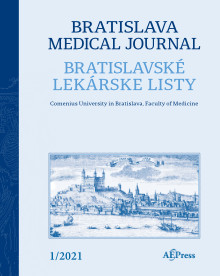Journal info
|
||||
Select Journal
Journals
Bratislava Medical Journal 2024 2023 2022 2021 2020 2019 2018 2017 2016 2015 2014 2013 2012 Ekologia - Ecology Endocrine Regulations General Physiology and Biophysics Neoplasma Acta Virologica Studia Psychologica Cardiology Letters Psychológia a patopsych. dieťaťa Kovove Materialy-Metallic Materials Slovenská hudba 2025Webshop Cart
Your Cart is currently empty.
Info: Your browser does not accept cookies. To put products into your cart and purchase them you need to enable cookies.
Bratislava Medical Journal Vol.124, No.1, p.42–46, 2023 |
||
| Title: Neutrophil‑to‑lymphocyte ratio as a marker of inflammation in restless legs syndrome during pregnancy | ||
| Author: Mustafa KARADENIZ, Merve Hazal SER, Mecbure NALBANTOGLU, Feray Bolukbasi TUMAY, Nevin YILMAZ, Serdar ACIKGOZ, Gulcin Benbir SENEL | ||
| Abstract: PURPOSE: The pregnancy is accepted as an independent risk factor for restless legs syndrome/Willis–Ekbom disease (RLS/WED). The neutrophil-to-lymphocyte ratio (NLR) was recently reported in the pathophysiology of RLS/WED. In this report, we investigated the relationship between the presence of RLS/WED and the levels of NLR in pregnancy. METHODS: We included 268 pregnant women attending routine prenatal visits; 148 women had RLS/WED, and 120 women without RLS/WED were the control group. A pre-formed questionnaire was administered to all participants regarding demographic characteristics, habitual behaviors, detailed medical history and questions about RLS/WED including disease duration, severity, and family history. Laboratory investigations were performed in all participants regarding the complete blood count, NLR, fasting blood glucose, blood urea nitrogen, creatinine, ferritin, and total iron binding capacity. RESULTS: NLR was significantly higher in pregnant women with RLS/WED as compared to those without it (3.9±0.9 versus 3.5±1.1, p=0.039). Smoking was also significantly more common in pregnant women with RLS/WED (p=0.022). NLR significantly increased as the gestational period progressed, even after the adjustments for age, BMI, and smoking (p=0.035). Higher NLR in pregnant women with RLS/WED was especially prominent in the 3rd trimester, although the difference was not significant. CONCLUSION: These results may suggest that an increased inflammation demonstrated by the increased NLR, may, in part, play a role in higher prevalence of RLS/WED in pregnancy, especially in late gestational weeks (Tab. 2, Fig. 1, Ref. 34). Text in PDF www.elis.sk |
||
| Keywords: neutrophil-to-lymphocyte ratio, restless legs syndrome/Willis-Ekbom disease, pregnancy, inflammation | ||
| Published online: 15-Dec-2022 | ||
| Year: 2023, Volume: 124, Issue: 1 | Page From: 42, Page To: 46 | |
| doi:10.4149/BLL_2023_006 |
||
|
|
 download file download file |
|

